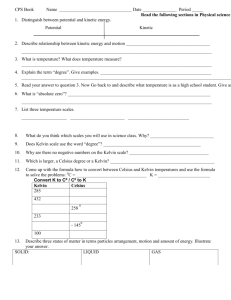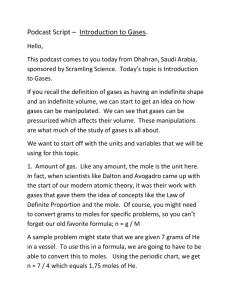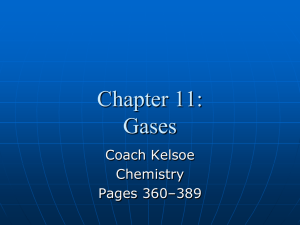Conversion Practice
advertisement
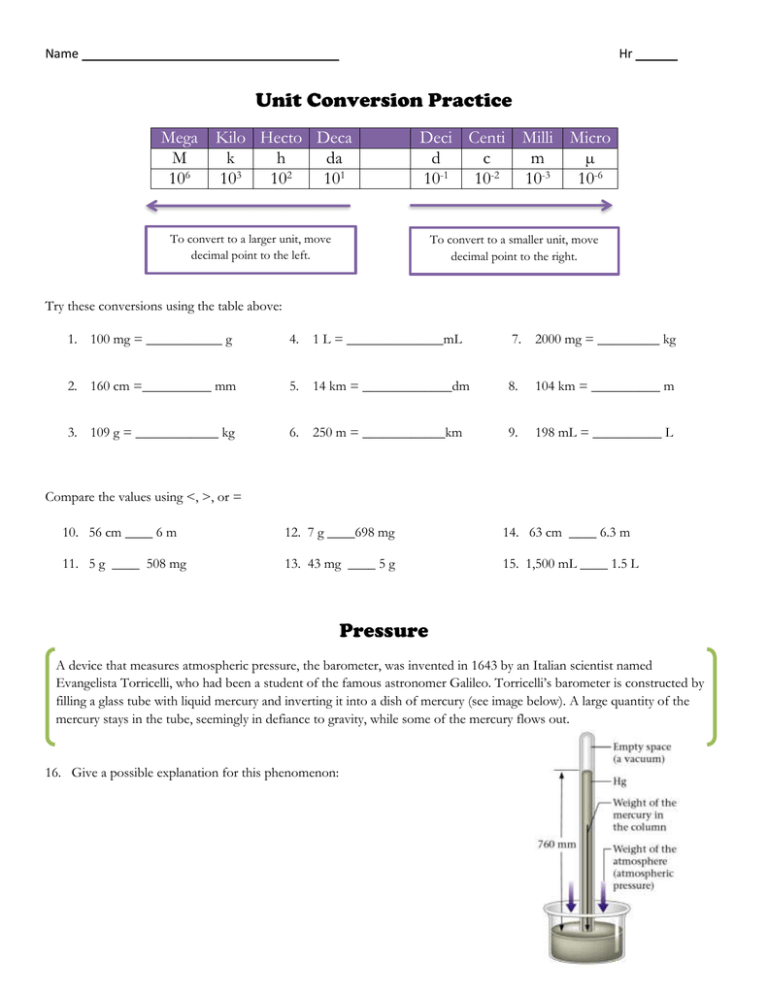
Name Hr Unit Conversion Practice Mega M 106 Kilo Hecto Deca k h da 3 2 10 10 101 Deci Centi Milli Micro d c m µ -1 -2 -3 10 10 10 10-6 To convert to a larger unit, move decimal point to the left. To convert to a smaller unit, move decimal point to the right. Try these conversions using the table above: 1. 100 mg = ___________ g 4. 1 L = ______________mL 7. 2000 mg = _________ kg 2. 160 cm =__________ mm 5. 14 km = _____________dm 8. 104 km = __________ m 3. 109 g = ____________ kg 6. 250 m = ____________km 9. 198 mL = __________ L Compare the values using <, >, or = 10. 56 cm ____ 6 m 12. 7 g ____698 mg 14. 63 cm ____ 6.3 m 11. 5 g ____ 508 mg 13. 43 mg ____ 5 g 15. 1,500 mL ____ 1.5 L Pressure A device that measures atmospheric pressure, the barometer, was invented in 1643 by an Italian scientist named Evangelista Torricelli, who had been a student of the famous astronomer Galileo. Torricelli’s barometer is constructed by filling a glass tube with liquid mercury and inverting it into a dish of mercury (see image below). A large quantity of the mercury stays in the tube, seemingly in defiance to gravity, while some of the mercury flows out. 16. Give a possible explanation for this phenomenon: The pressure of a gas can be represented in a couple of different units. Gas pressure can be measured in a unit called a standard atmosphere (atm). 1 atm is equal to 760 millimeters of mercury (mm Hg). The unit millimeters of mercury can also be referred to as the torr (named after Torricelli). The SI unit for pressure is the Pascal (Pa). 1 atmosphere is equivalent to 101,325 Pascals, or about 101 kiloPascals (kPa). So, the conversions go like this: 1 atm = 760 mm Hg = 760 torr ≈ 101,000 Pa ≈ 101 kPa Use your knowledge of converting metric units, and the information above about converting between units of pressure to solve the following problems. Show your work. Make sure to check your units! 17. Convert the following pressures into units of mm Hg: 18. Convert the following pressures into atmospheres: a. 0.9975 atm a. b. 225,400 Pa b. 752 mm Hg c. 99.7 kPa c. 105.2 kPa 75.2 cm Hg Temperature Temperature can be expressed in three different ways: degrees Fahrenheit, degrees Celsius, and Kelvin. In this unit, we will be dealing with Celsius and Kelvin. To convert degrees Celsius to Kelvin is very simple: all you need to do is add the number in Celsius to 273. Example: 19. Convert 73.8°C to Kelvin: 10°C + 273 = 283 K 20. Convert 623 K to degrees Celsius:


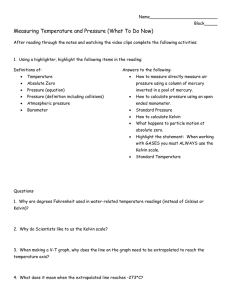
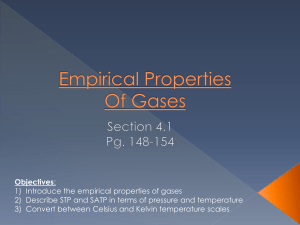
![Temperature Notes [9/22/2015]](http://s3.studylib.net/store/data/006907012_1-3fc2d93efdacd086a05519765259a482-300x300.png)


